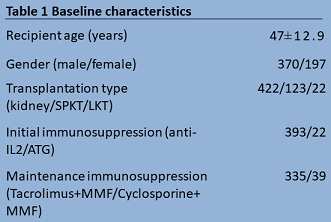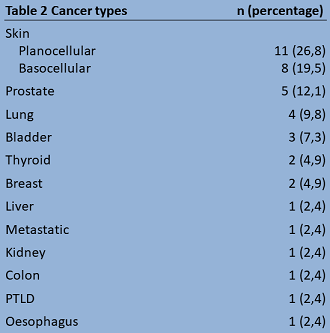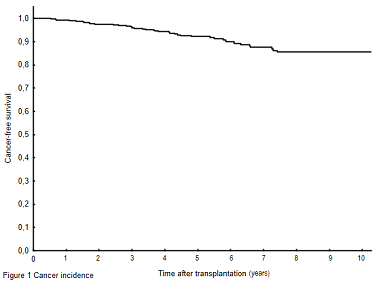Long-term Cancer Incidence in Kidney Transplant Recipients in Relation to the First Posttransplant Year Immunossuppresion Intensity
Ivan Margeta1, Snježana Šulc1, Marina Zelenika1, Željka Jureković1, Bojana Maksimović1,2, Marija Dorotić1, Ivana Mrnjec1, Mladen Knotek1,2.
1Department of Nephrology, University Hospital “Merkur”, Zagreb, Croatia; 2School of Medicine, University of Zagreb, Zagreb, Croatia
Introduction: Cancer, along with cardiovascular diseases and infections is one of the leading causes of death in kidney transplant recipients. Transplant patients have a higher risk of cancer than the general population. The aim of our study was to determine the long-term incidence of cancer in kidney transplant recipients with respect to immunossuppresion intensity in the first posttransplant year.
Methods: We retrospectively analysed data on all kidney transplant recipients transplanted in the Merkur hospital from 6.6.2003. to 31.12.2016. We included all kidney transplant recipients (single kindey transplantation, simultaneous liver and kidney transplantation [LKT] and simultaneous pancreas and kidney transplantation [SPKT]). Immunossupression consisted of an anti-IL2R antibody or anti-thymocyte immunoglobulin induction with calcineurin inhibitor, mycophenolate ± steroid maintenance (Table 1).
Results: The study included 567 kidney transplant recipients (Table 1). Cancer occurred in 41 (7.23%) patients. The 5-year incidence of cancer was 7.8% and 10-year incidence was 14.7% (Figure 1). The standardized incidence ratio was 3.27 (calculated by cumulative and age-standardized rates of cancer incidence in croatian population). The most common were skin cancers with nineteen newly diagnosed patients. Remaining 22 patients were diagnosed with other types of cancer (Table 2). Comparison of Kaplan-Meier curves showed a statistically significant difference (p=0.0003; log-rank test) in cancer incidence among different types of transplantation (kidney, LK and SPKT). LKT recipients had the highest incidence of malignant diseases, followed by kidney-only recipients. SPKT recipients had the lowest incidence rate. Univariate analysis showed that cancer incidence correlated also with older age (p<0.001). Immunosuppression (induction, as well as type and cumulative doses/concentrations of maintenance immunosuppressive drugs within first posttransplant year) had no statistically relevant association with cancer incidence. Older age remained the only independent risk factor for cancer development in multivariate Cox regression (HR 1.07, CI 1.04-1.11, p<0.001).
Conclusion: Cancer incidence in kidney transplant recipients is higher when compared with cancer incidence in the general population. Cancer incidence is dependent on recipient age. There was no association with immunosuppression intensity in the first post-transplantation year and appearence of cancer.


